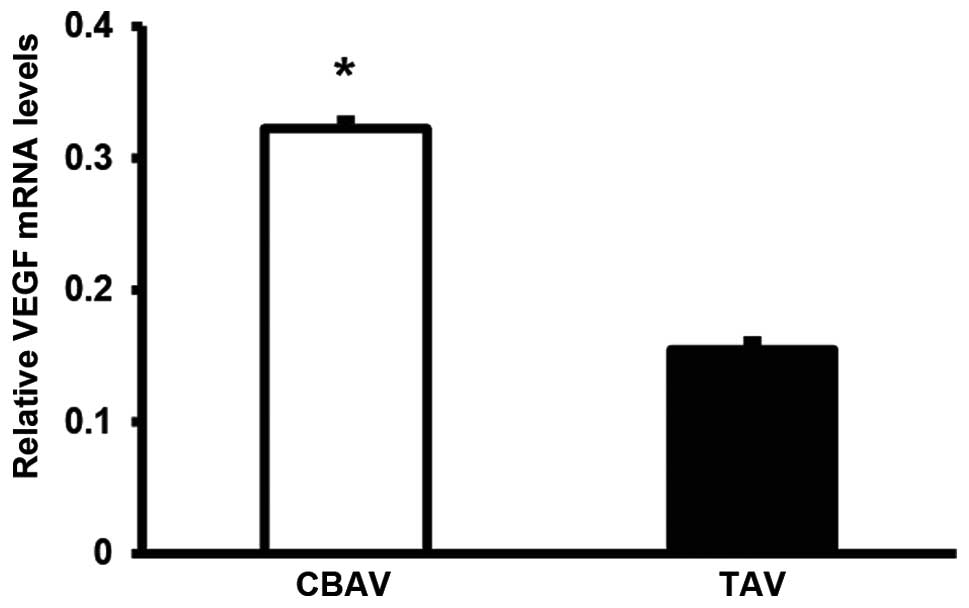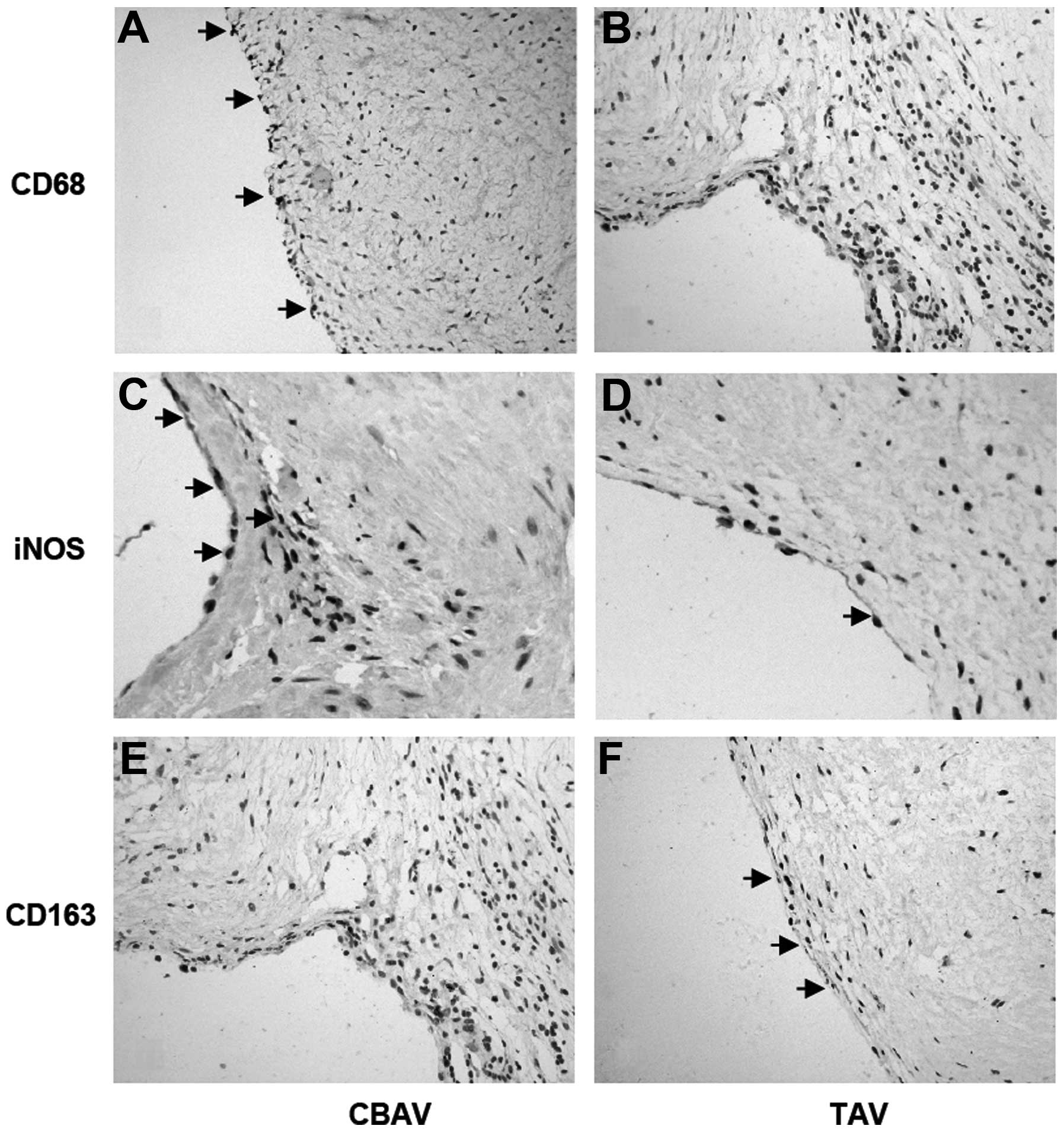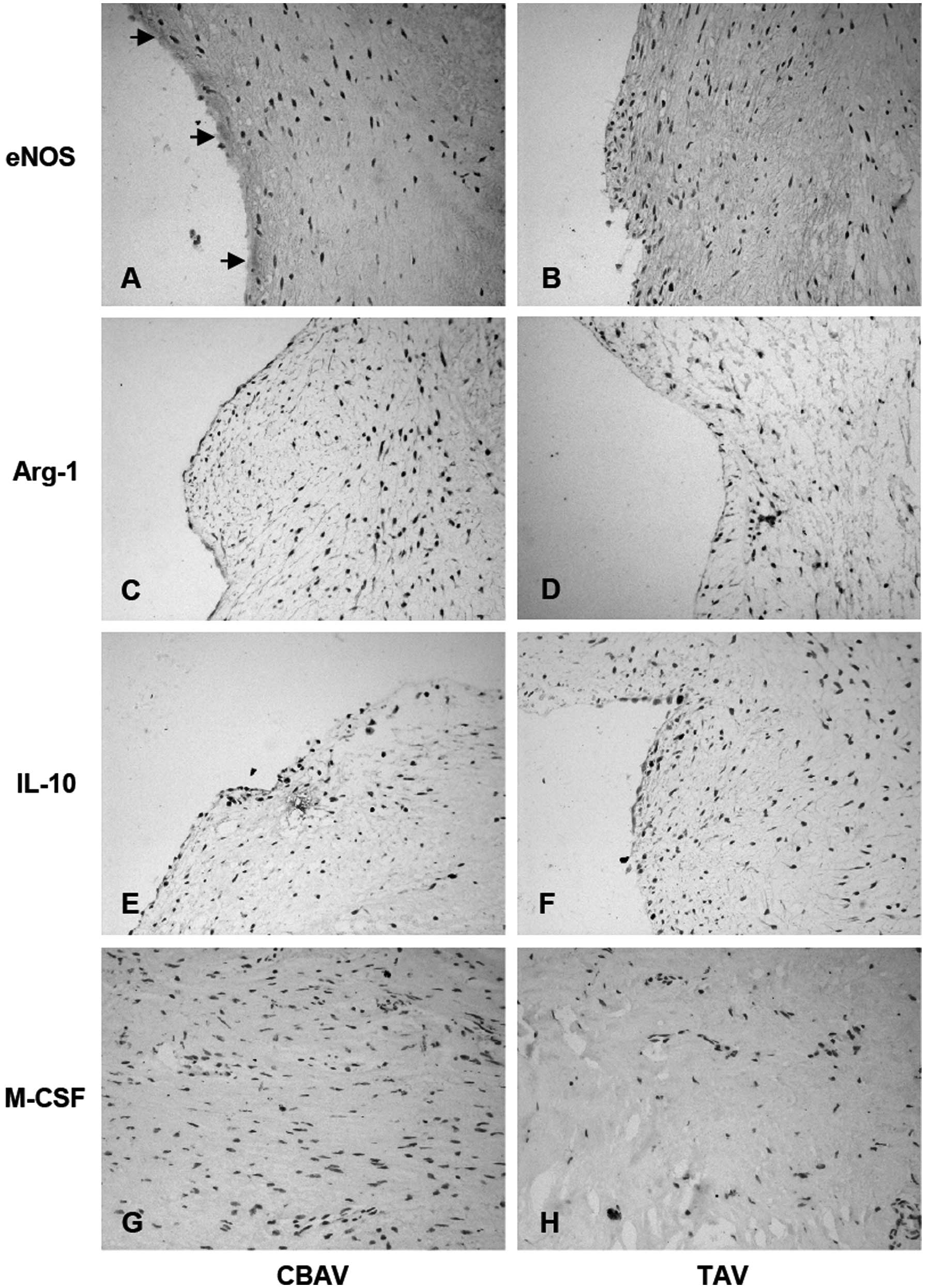|
1
|
Ward C: Clinical significance of the
bicuspid aortic valve. Heart. 83:81–85. 2000. View Article : Google Scholar : PubMed/NCBI
|
|
2
|
Michelena HI, Desjardins VA, Avierinos JF,
Russo A, Nkomo VT, Sundt TM, Pellikka PA, Tajik AJ and
Enriquez-Sarano M: Natural history of asymptomatic patients with
normally functioning or minimally dysfunctional bicuspid aortic
valve in the community. Circulation. 117:2776–2784. 2008.
View Article : Google Scholar : PubMed/NCBI
|
|
3
|
Otto CM: Calcification of bicuspid aortic
valves. Heart. 88:321–322. 2002. View Article : Google Scholar : PubMed/NCBI
|
|
4
|
Nigam V and Srivastava D: Notch1 represses
osteogenic pathways in aortic valve cells. J Mol Cell Cardiol.
47:828–834. 2009. View Article : Google Scholar : PubMed/NCBI
|
|
5
|
Weinberg EJ, Kaazempur and Mofrad MR: A
multiscale computational comparison of the bicuspid and tricuspid
aortic valves in relation to calcific aortic stenosis. J Biomech.
41:3482–3487. 2008. View Article : Google Scholar : PubMed/NCBI
|
|
6
|
McKellar SH, Tester DJ, Yagubyan M,
Majumdar R, Ackerman MJ and Sundt TM III: Novel NOTCH1 mutations in
patients with bicuspid aortic valve disease and thoracic aortic
aneurysms. J Thorac Cardiovasc Surg. 134:290–296. 2007. View Article : Google Scholar : PubMed/NCBI
|
|
7
|
Jaguin M, Houlbert N, Fardel O and
Lecureur V: Polarization profiles of human M-CSF-generated
macrophages and comparison of M1-markers in classically activated
macrophages from GM-CSF and M-CSF origin. Cell Immunol. 281:51–61.
2013. View Article : Google Scholar : PubMed/NCBI
|
|
8
|
Chu EM, Tai DC, Beer JL and Hill JS:
Macrophage heterogeneity and cholesterol homeostasis:
classically-activated macrophages are associated with reduced
cholesterol accumulation following treatment with oxidized LDL.
Biochim Biophys Acta. 1831:378–386. 2013. View Article : Google Scholar
|
|
9
|
Gordon S and Taylor PR: Monocyte and
macrophage heterogeneity. Nat Rev Immunol. 5:953–964. 2005.
View Article : Google Scholar : PubMed/NCBI
|
|
10
|
Ma J, Liu L, Che G, Yu N, Dai F and You Z:
The M1 form of tumor-associated macrophages in non-small cell lung
cancer is positively associated with survival time. BMC Cancer.
10:1122010. View Article : Google Scholar : PubMed/NCBI
|
|
11
|
Johnson JL and Newby AC: Macrophage
heterogeneity in atherosclerotic plaques. Curr Opin Lipidol.
20:370–378. 2009. View Article : Google Scholar : PubMed/NCBI
|
|
12
|
Mosser DM and Edwards JP: Exploring the
full spectrum of macrophage activation. Nat Rev Immunol. 8:958–969.
2008. View
Article : Google Scholar : PubMed/NCBI
|
|
13
|
Edin S, Wikberg ML, Dahlin AM, Rutegård J,
Öberg Å, Oldenborg PA and Palmqvist R: The distribution of
macrophages with a M1 or M2 phenotype in relation to prognosis and
the molecular characteristics of colorectal cancer. PLoS One.
7:e470452012. View Article : Google Scholar : PubMed/NCBI
|
|
14
|
Zhao M, Fu XL and Lv H: The expression of
EGFR in oral lichen planus, squamous cell papilloma and squamous
cell carcinoma. Shanghai Kou Qiang Yi Xue. 21:673–676. 2012.(In
Chinese).
|
|
15
|
Goldbarg SH, Elmariah S, Miller MA and
Fuster V: Insights into degenerative aortic valve disease. J Am
Coll Cardiol. 50:1205–1213. 2007. View Article : Google Scholar : PubMed/NCBI
|
|
16
|
Yu PJ, Skolnick A, Ferrari G, et al:
Correlation between plasma osteopontin levels and aortic valve
calcification: potential insights into the pathogenesis of aortic
valve calcification and stenosis. J Thorac Cardiovasc Surg.
138:196–199. 2009. View Article : Google Scholar
|
|
17
|
Soini Y, Salo T and Satta J: Angiogenesis
is involved in the pathogenesis of nonrheumatic aortic valve
stenosis. Hum Pathol. 34:756–763. 2003. View Article : Google Scholar : PubMed/NCBI
|
|
18
|
Roberts WC: The congenitally bicuspid
aortic valve. A study of 85 autopsy cases. Am J Cardiol. 26:72–83.
1970. View Article : Google Scholar : PubMed/NCBI
|
|
19
|
Falcone MW, Roberts WC, Morrow AG and
Perloff JK: Congenital aortic stenosis resulting from a
unicommisssural valve. Clinical and anatomic features in twenty-one
adult patients. Circulation. 44:272–280. 1971. View Article : Google Scholar : PubMed/NCBI
|
|
20
|
Moreno PR, Astudillo L, Elmariah S,
Purushothaman KR, Purushothaman M, Lento PA, Sharma SK, Fuster V
and Adams DH: Increased macrophage infiltration and
neovascularization in congenital bicuspid aortic valve stenosis. J
Thorac Cardiovasc Surg. 142:895–901. 2011. View Article : Google Scholar : PubMed/NCBI
|
|
21
|
Winchester R, Wiesendanger M, O’Brien W,
Zhang HZ, Maurer MS, Gillam LD, Schwartz A, Marboe C and Stewart
AS: Circulating activated and effector memory T cells are
associated with calcification and clonal expansions in bicuspid and
tricuspid valves of calcific aortic stenosis. J Immunol.
187:1006–1014. 2011. View Article : Google Scholar : PubMed/NCBI
|
|
22
|
Mantovani A, Sica A, Sozzani S, Allavena
P, Vecchi A and Locati M: The chemokine system in diverse forms of
macrophage activation and polarization. Trends Immunol. 25:677–686.
2004. View Article : Google Scholar : PubMed/NCBI
|
|
23
|
Tugal D, Liao X and Jain MK:
Transcriptional control of macrophage polarization. Arterioscler
Thromb Vasc Biol. 33:1135–1144. 2013. View Article : Google Scholar : PubMed/NCBI
|
|
24
|
Bronte V and Zanovello P: Regulation of
immune responses by L-arginine metabolism. Nat Rev Immunol.
5:641–654. 2005. View
Article : Google Scholar : PubMed/NCBI
|
|
25
|
Martinez FO, Gordon S, Locati M and
Mantovani A: Transcriptional profiling of the human
monocyte-to-macrophage differentiation and polarization: new
molecules and patterns of gene expression. J Immunol.
177:7303–7311. 2006. View Article : Google Scholar : PubMed/NCBI
|
|
26
|
Bouhlel MA, Derudas B, Rigamonti E, et al:
PPARgamma activation primes human monocytes into alternative M2
macrophages with anti-inflammatory properties. Cell Metab.
6:137–143. 2007. View Article : Google Scholar : PubMed/NCBI
|
|
27
|
Randolph GJ, Jakubzick C and Qu C: Antigen
presentation by monocytes and monocyte-derived cells. Curr Opin
Immunol. 20:52–60. 2008. View Article : Google Scholar : PubMed/NCBI
|
|
28
|
Dorfmüller P, Bazin D, Aubert S, Weil R,
Brisset F, Daudon M, Capron F and Brochériou I: Crystalline
ultrastructures, inflammatory elements, and neoangiogenesis are
present in inconspicuous aortic valve tissue. Cardiol Res Pract.
2010:6859262010.PubMed/NCBI
|














